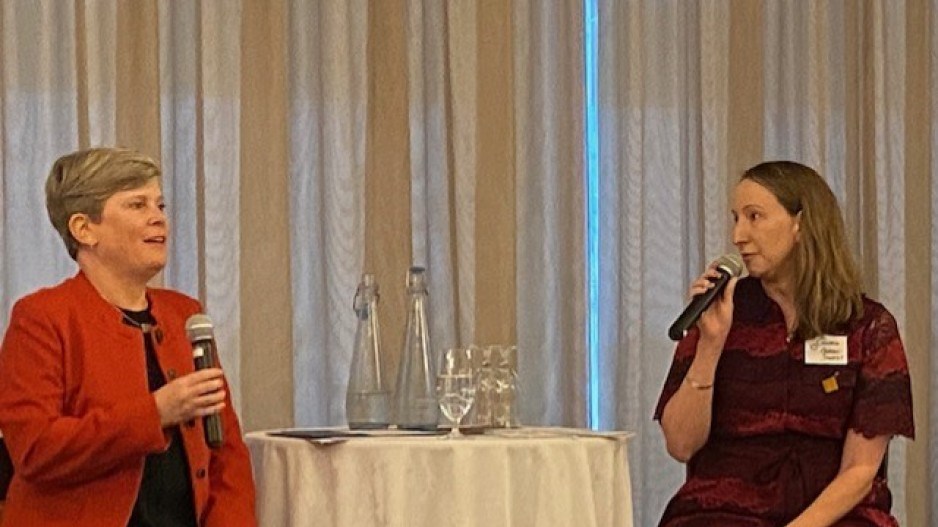British Columbia’s abundant, clean and relatively low-cost hydro power has long been touted as one of British Columbia’s greatest industrial advantages.
But it has become such a drawing card that some are now wondering whether B.C. will actually have enough power to satisfy the demand from all the projects being proposed in B.C., from liquefied natural gas plants with electric drive to green hydrogen plants.
A $2 billion green hydrogen plant being proposed Prince George by Fortescue Future Industries (FFI), for example, calls for a 1,000 megawatt electrolyser. That’s about 4,600 gigawatts per hour (GW/h), or 90 per cent of the new Site C dam’s generating capacity.
The McLeod Lake Indian Band and Mitsubishi also announced a plan earlier this year to build a green and blue hydrogen plant north of Prince George. (Green hydrogen is made from water and electricity; blue hydrogen is made from natural gas, with carbon capture.)
“The production of green hydrogen, like the liquification of natural gas, is highly power intensive,” write Richard McClandless, a former B.C. government bureaucrat who now blogs about public policy. “The FFI requirement alone is far beyond BC Hydro’s current or planned domestic supply.”
Meeting the growing industrial demand for clean electricity is one of challenges B.C.’s minister of Energy, Mines, and Low Carbon Innovation, Josie Osborne, faces.
At a breakfast meeting with the resource industry community Tuesday, Osborne touched on some of these challenges and talked about how here government plans to meet them.
While she didn’t specifically address the demand for power from the Fortescue proposal, Osborne did talk about industrial electricity demand in general, and suggested that the province and BC Hydro will build new generating and transmission as needed.
Earlier this year, BC Hydro issued an expression of interest to try to get a better idea of the potential industrial demand in the Prince George region, Osborne said. It got 29 submissions from potential customers. It’s not clear if the Fortescue project was among the 29 expressions of interest, though Osborne said hydrogen projects were among the responses.
“These customers include (the) LNG industry, mining, ports, hydrogen and others,” she said.
“It has raised questions about BC Hydro’s ability to provide enough power to meet the demands of our low carbon future,” she acknowledged.
In June, BC Hydro announced it would issue a new clean power call in 2024 to obtain about 3,000 gigawatt hours (GW/h) of new power. Osborne added that “the first call for power…will be followed by subsequent calls, as they are needed, as this province electrifies.”
In other words, the 3,000 GW/h that BC Hydro plans to obtain in its next power call may just be the first tranche of other power calls to come.
Apart from green hydrogen production, the other big industrial demands for new power will come from mining and the oil and gas industry, notably LNG.
Osborne noted that mining in B.C. already sustains 30,000 direct jobs, and last year set a production value record of $18 billion. Some of the metals that B.C. either produces or could produce are critical to the energy transition – things like copper and nickel. The B.C. government is very much on board with mining critical minerals that are critical to the energy transition needed to address climate change.
“The mining sector has the potential to provide many of the critical minerals and metals that are necessary to fight climate change,” Osborne said.
The B.C. government is working on a critical minerals strategy that will promote not just mining, but associated industries like processing, manufacturing, and battery recycling.
Osborne acknowledged that the mining sector faces regulatory delays, though she suggested some progress is being made on that front.
She noted that her government earmarked $66 million in the last provincial budget to speed up permitting. She pointed to the Blackwater mine as proof the regulatory process can be sped up.
“The major mine permit in that case was issued in just 10 months, and that’s the kind of progress we need to see,” she said.
As for oil and gas, that is a file that is trickier to balance.
Because it is so emissions intense (accounting for 20 per cent of B.C. greenhouse emissions), there are strong arguments being made to phase the industry out altogether, and halt any further development of LNG projects.
“I think many of you have heard the premier speak to this, when he says there are some folks out there who would say we really should just stop everything, and we shouldn’t have any kind of development,” Osborne said. “And we know that would come at the cost of jobs.”
She noted that, in March, when her government granted the Haisla First Nation and its partners the green light for its Cedar LNG project, it also rolled out new emissions caps for the oil, gas and LNG sector via the new Energy Action Framework. It will require any new LNG projects not yet approved to meet new net zero requirements.
“The net zero requirement will ensure that future LNG projects are in line with our climate commitments,” Osborne said.





